![]()
![]()
![]()
Use LEFT and RIGHT arrow keys to navigate between flashcards;
Use UP and DOWN arrow keys to flip the card;
H to show hint;
A reads text to speech;
160 Cards in this Set
- Front
- Back
|
What fraction of the cortex do we understand?
|
one third
|
|
|
Show the blood supple to the cortex (ACA, MCA, and PCA)
|
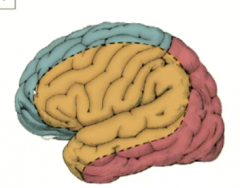
|
|
|
What is the blood supply to the lateral part of each hemisphere?
|
MCA
|
|
|
Show the blood supply to the medial cerebral hemisphere.
|
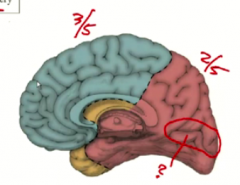
|
|
|
What is special about the central sulcus? How can you identify it?
|
It is the only sulus to go all the way to the medial side of the cerebral hemisphere
|
|
|
Show which parts of the motor cotex supply corticobulbar/cranial nerves vs corticospinal.
|
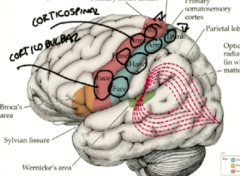
|
|
|
WHat is the major blood supply to the somatosensory and motor cortex?
|
middle cerebral artery
|
|
|
What sensations and movements would you lose in a left MCA infarct? Show it.
|
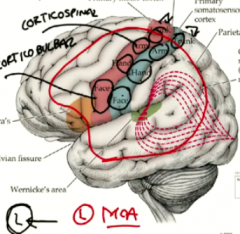
Right side motor and sensation from the arms up.
|
|
|
What blood vessel would knock off the function of the rest of the homunculi? SHow it's territory!
|
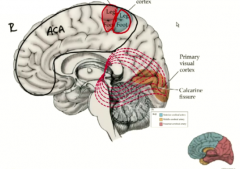
The ACA resp for anterior 3/5 of the medial part of the hemisphere.
|
|
|
So which two arteries affect the motor and sensory homunculi?
|
ACA and MCA
|
|
|
Do the cranial nerves get contralateral innervation? Is there an exception?
|
No, they get bilateral! except fot the facial nerve
|
|
|
Define and show the boundaries of the prefrontal cortex.
|
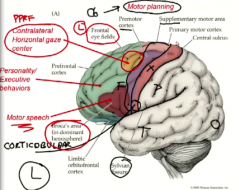
In green. It is the excess area that is past the motor cortexes in the frontal lobe
|
|
|
NOW WE TALK ABOUT DOMINANT HEMISPHERES!
|
YAY!
|
|
|
Are we talking about left and right in this next section or dominant and nondominant?
|
dominant and nondominant
|
|
|
Can you still be left brain dominant if you are left handed? Statistic?
|
Yes, 60% of let handed people are left brain dominant.
|
|
|
Can the nondominant also play a role in speech? Describe the difference.
|
Yes, but not as strongly.
nondominant: prosody- create and understand emotional tone dominant: language- create and understand speech |
|
|
Which capability do dogs have more of?
|
prosody
|
|
|
What does it mean if we are right handed?
|
The UMN's coming from the left are more skilled.
|
|
|
Compare dominant and nondominant in their different abilities for math.
|
dominant- can manipulate numbers and do calculations
nondominant- can organize numbers in rows |
|
|
Compare dominant and nondominant in their different abilities for motor tasks and spatial awareness.
|
dominant- skilled motor formation
nondominant- spatial awareness and analysis |
|
|
What is a word for skilled motor formation (like writing)?
|
praxis
|
|
|
Compare dominant and nondominant in their different abilities for musical ability.
|
dominant- more active in train musicians
nondominant- more active in untrained musicians |
|
|
So what are you trying to shift about your musical center by training musically?
|
trying to shift it to the dominant side
|
|
|
Compare dominant and nondominant in their different abilities for sense of direction.
|
dominant- can follow set of written directions in sequnce
nondominant- being able to generally sense where you are spatially |
|
|
NOW WE TALK ABOUT SPEECH CENTERS!
|
WERNIIIIE
|
|
|
Which side of the brain are broca's and wernicke's area on?
|
the dominant side.
|
|
|
What functional areas are broca's vs wernicke's area by?
|
broca's- by the vocal motor cortex
Wernicke's- the auditory cortex |
|
|
Which two functional cortexes are near Wernicke's area?
|
visual written and auditory
|
|
|
What is the name for the written comprehension cortex called?
|
the angular gyrus
|
|
|
Why is angulate gyrus called what it is?
|
It makes an angle where the sylvian fissure ends
|
|
|
What area is the angular gyrus near? Why is this advantageous?
|
the visual cortex so you can comprehend what you see written down
|
|
|
Show wernicke's area with it's two related areas that will feed it info.
|
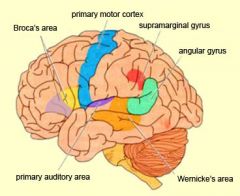
|
|
|
Which is the largest lobe by far?
|
frontal
|
|
|
What is held in the frontal lobe besides the frontal eye field and Broca's?
|
We don't exactly know, but it contains our personality and learned experiences
|
|
|
What is the number for the angular gyrus/written comprehension center?
|
39
|
|
|
Show the angular gyrus
|
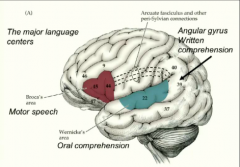
|
|
|
what vessel supplies all the language centers?
|
the MCA on the dominant side
|
|
|
Give the table of stats for which side is dominant for which handedness
|
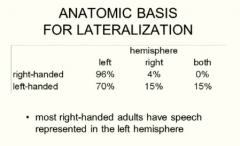
|
|
|
What is area 4?
|
primary motor cortex
|
|
|
What are areas 3, 1, and 2?
|
Somatosensory cortex
|
|
|
What is area 44 and 45? Mnemonic?
|
Broca's\
Tom Broca was 44 and 45 throughout his peak |
|
|
What number is the frontal eye field? Mnemonic?
|
8
looks like a pair of glasses |
|
|
Give the image with all the brodmann's numbers
|
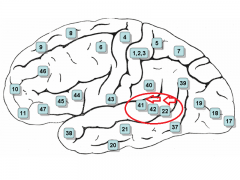
|
|
|
Define apraxia.
|
the inability to perform a movement despite the will and physical capacity to do so
|
|
|
What would you call disordered movement? Is this the name.
|
ataxia and no
|
|
|
define -praxia
|
performance of movements
|
|
|
What is wrong in a person with apraxia?
|
they lack the higher planning centers for movement (premotor or supplementary motor cortex)
|
|
|
Breakdown agnosia
|
a- not
gnosia- knowing not knowing (a sensation) |
|
|
Breakdown astereognosia.
|
no knowledge of 3D shapes (stereo)
|
|
|
What side would you have somatosensory agnosia in if you have the lesion on the left?
|
on the right
|
|
|
What is lesioned in a stereoagnosia?
|
the somatosensory association cortex
|
|
|
So what are the higher cerebral dysfunction associated disorders?
|
apraxia and agnosia
|
|
|
What is an apraxic gait like?
|
they can't really take steps on their own but can shuffle a little when pulled
|
|
|
What is apraxic speech like?
|
garbled. can't understand it.
|
|
|
What sx usually accompanies any kind of aphasia? Why?
|
a or dys graphia because all of the same centers are needed as for verbal language
|
|
|
What is a classic test for aphasia repetition?
|
repeat the phrase, "no ifs, ands, or buts"
|
|
|
What kind of speech would a pt with Broca's aphasia have?
|
reduced to monosyllabic speech
|
|
|
What kind of weakness would a pt with broca's have? Where?
|
spastic weakness of lower face and upper limb contralaterally
|
|
|
Do you process sound bilaterally or unilaterally? How do you know?
|
bilaterally. because some cochlear fibers cross in the trapezoid body and some do not
|
|
|
Who is more frustrated/unaware of their disorder? (b/w)
|
unaware or not concerned- wernicke's
frustrated- broca's |
|
|
What do pts with Wernicke's usually attribute their deficit to?
|
hearing loss or other people not speaking clearly.
|
|
|
What sx accompanies b/w aphasia? and mimic the way we tallk?
|
agraphia (they write the way their aphsia makes them talk)
|
|
|
What function is lost with an angular gyrus lesion?
|
ability to read
you get alexia |
|
|
breakdown alexia? What common disorder has the same root?
|
a- no
lexia- reading dyslexia is impaired reading |
|
|
What region(s) are the math centers? Name and show them.
|

40 and 39
(39 in angular gyrus) |
|
|
What is the lesion in Gerstmann syndrome?
|
the angular gyrus (brodmann 39)
|
|
|
What are the 4 sx of Gerstmann Syndrome?
|
1. alexia
2. agraphia 3. acalculia 4. finger agnosia |
|
|
explain the alexia
|
this is the written comprehension center
|
|
|
explain the agraphia
|
this center is like wernicke's for speech and wernicke's tends to make word salad because it provides the words to say on top of just understanding them
|
|
|
explain the acalculia
|
the math center is in the angular gyrus (as well as in the neighboring brodmann 40)
|
|
|
explain the finger agnosia
|
we probably learned to count on our fingers at an early age so our finger identification is involved in our math center
|
|
|
explain the disability in finger agnosia
|
you ask a person to point to their index finger (usually the right because the center is on the left) and they can't
|
|
|
.;Where is the lesion in gerstann's?
|
dominant parietal lobe
|
|
|
Will people with Gerstman's know about their deficit?
|
probably not. either that or they are not concerned.
|
|
|
Sum up the affected areas in Gerstmann's syndrome?
|
the dominant parietal lobe around the angular gyrus is lesioned. It knocks out the written comprehension and math centers.
|
|
|
What happens if you have a lesion of the nondominant parietal lobe? Explain the sx.
|
unilateral neglect. Pt doesn't take care of the contralateral side because they don't think it belongs to them.
|
|
|
How did the one lady describe what having unilateral neglect was like?
|
it was like she was only paying attention to one side and didn't realize she didn't do the other side till it was pointed out.
|
|
|
What is the classic test for unilateral neglect?
|
drawing a clockface
|
|
|
Is it possible for them not to be able to see the left side at all? How?
|
Yes, if they have enough damage that their visual cortex is also affected
|
|
|
Show the territories of blood supply again
|
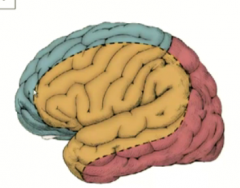
|
|
|
What kind of aphasia would a ACA infarct product?
|
transcortical motor aphasia
|
|
|
What syndromes would result from dominant MCA infarction?
|
aphasias and Gerstmann's syndrome
|
|
|
What syndromes would result from nondominant MCA infarction?
Why nondominant? |
unilateral neglect and spatial perception deficits
this side is more specialized for spatial awareness |
|
|
What lobe(s) does the PCA cover?
|
part of the upper parietal and the occipital
|
|
|
How would a PCA infarct affect the occipital lobe? What is this called and what is spared?
|
you would get contralateral lack of visual processsing presenting as homonomous hemianopsia with macular sparing
|
|
|
Breakdown homonomous hemianopsia
|
Homonymous: (having the same name or designation) or standing in the same relation
hemi: half anopsia: blindness |
|
|
What does it look like to have Homonymous hemianopsia from a right PCA lesion?
|

can't see the left half of both eye field
|
|
|
What is macular sparing? Show what it would look like to the pt.
|

when the center 5-10 degrees is not affected
|
|
|
Show the macula. What is here?
|
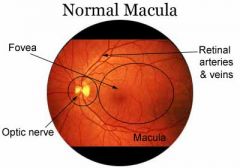
a high concentration of color cone cells
|
|
|
Why are the macula spared?
|
because they have a readily available source of blood supply from the MCA
|
|
|
What deficit will you get with a dominant PCA infarct on the parietal/occipital lobe junction area?
|
alexia without agraphia
|
|
|
In processing stimuli, What are the 2nd and 3rd areas together called? (analysis and recognition)
|
association area
|
|
|
What is another name for the receiving area? (1st)
|
The primary area
|
|
|
Mnemonic for visual cortex numbers?
|
You start to see the world at 17
|
|
|
Mnemonic for auditory cortex numbers?
|

When she hears the noise of sin,
22- Nun 41- Rat 42- Runs |
|
|
WHat info exactly does Broca's area contain?
|
the motor programs for saying certain words.
|
|
|
Do you talk during inspiration or expiration? Why?
|
expiration because you are pumping air out of the vocal cords
|
|
|
What do you call the production of sound?
|
phonation
|
|
|
What is the main structure associated with phonation?
|
layrnx (with vocal cords)
|
|
|
What is articulation then?
|
The process of modulation the sound to produce words
|
|
|
What are the structures associated with artculation? (5)
|
1. larynx
2. tongue 3. pharynx 4. lips 5. soft palate |
|
|
Show which cranial nerves control each structure for articulation (assume 9 just goes with 10)
|
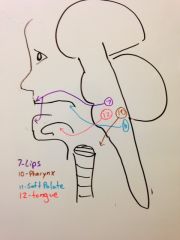
|
|
|
If articulation needs to be very coordinated, what do the 7, 9, 10, 11, and 12th nuclei have to be heavily connected to?
|
the cerebellum and primary motor area assoiated with broca's
|
|
|
What is a dys-phonia?
|
problem with the production of sound
|
|
|
What are two broad reasons for dysphonias?
|
1. psychological
2. physiological |
|
|
Which structures are ultimately affected in dysphonias or aphonias?
|
The larynx or the respiratory system
|
|
|
What is dysarthria?
|
trouble articulating
|
|
|
What are some reasons for dysarthria? (5)
|
1. cerebellar dysfunction
2. UMN (corticobulbar) 3. LMN (cranial nerves) 4. NMJ 5. Muscle pathology |
|
|
What would the articulation result of cerebellar dysfunction be? (think drunk people with cerebellar dysfunction in purkinjies)
|
slurring of speech due to incoordination of the muscles
|
|
|
What are the two types of UMN caused dysarthria?
|
pyrimidal vs extrapyrimidal
|
|
|
Give an example of each.
|
pyrimidal- spastic dysarthria
extrapyrimidal- parkinsons (unable to start or stop speech well) |
|
|
Give 2 examples of a LMN problem.
|
tumpr in the brainstem area.
Bell's palsy |
|
|
Give an example of a NMJ problem. Is this dysphonia or dysarthria?
|
myasthenia gravis. It is both
|
|
|
NOW WE TALK ABOUT DYSPHASIA AND APHASIA
|
YAY!
|
|
|
What areas can be defective in a or dys phasias?
|
broca's, wernicke's, or arcuate fasiculus
|
|
|
Which areas are ok in -phasias?
|
all the ones listed for dysarthrias. (5)
plus vision and hearing processing |
|
|
So describe aphasia pathologically.
|
There is a problem with the higher language centers that decode and encode language (verbal, written, or signs)
|
|
|
Just like in any other movement, what two structures need to be consulted before speech is made?
|
the basal ganglia and the cerebellum
|
|
|
Sx for Broca's aphasia
|
1. Can't say words
2. Can't repeat words |
|
|
What are some alternate names for Broca's aphasia? (4)
|
1. anterior aphasia
2. expressive aphasia 3. nonfluent aphasia 4. mute aphasia |
|
|
Sx for Wernicke's aphasia?
|
1. Can't understand speech
2. Can't repeat speech 3. Word salad without knowing it |
|
|
Why don't you recognize that you said the wrong word?
|
you can't understand your own words
|
|
|
Why do you say the wrong word? (2 of my own theories)
|
1. your programs for words are intact, but your mental dictionary is out of whack
2. you cannot correct yourself (normal people say wrong words too) |
|
|
What two types of nonsensical speech can someone with Wernicke's say?
|
1. word salad (wrong word)
2. neoligisms (make up new words) |
|
|
What are 3 alternative names for wernicke's aphasia?
|
1. Posterior aphasia
2. Receptive aphasia 3. Fluent aphasia |
|
|
What do you call it when you are adding unintended words and syllables to your speech?
|
paraphasia
|
|
|
What speech ability is the arcuate fasiculus responsible for?
|
repetition
|
|
|
What is another name for a arcuate fasiculus lesion?
|
conduction aphasia
|
|
|
How common is this aphasia compared to the others?
|
much more rare
|
|
|
What is it like to have conduction aphasia?
|
You cannot repeat back things said to you
You have difficulty correct yourself when you mispeak although you recognize it |
|
|
What disability is common between all of the aphasias?
|
problem with repetition
|
|
|
define transcortical
|
of or relating to nerve pathways that cross the cerebral cortex of the brain.
|
|
|
What is the lesion in transcortical motor aphasia? Show it.
|
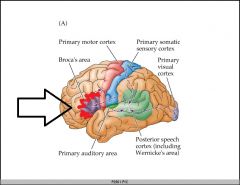
cut off broca's from the rest of the frontal cortex
|
|
|
What is the sx in transcortical motor aphasia?
|
difficulty in saying the things you want to say (frontal to broca disconnection), but with repetition intact
|
|
|
What is the lesion in transcortical sensory aphasia? Show it.
|

|
|
|
What ability is commonly retained in both trancortical motor and sensory aphasia?
|
the ability to repeat something because wernicke's broca's area and their connections are intact.
|
|
|
What is the sx in transcortical sensory aphasia?
|
You cannot understand language, but can repeat sounds and written words.
|
|
|
WHat is mixed transcortical aphasia?
|
when it is both motor and sensory
|
|
|
What is the sx of nominal aphasia?
|
you know it is a book for reading, but call it a car.
repetition is intact |
|
|
What is damaged in nominal aphasia supposedly? (mnemonic)
|
the posterior part of wericke's. similar to a word salad phenomenon
|
|
|
What is lesioned in global aphasia?
|
everything from broca's to arcuate to wernicke's
|
|
|
What lesions can imitate Broca's vs Wernicke's aphasia?
|
Broca's- anterior BG (caudate head and putamen)
Wernicke's- posterior BG (GPi and e) |
|
|
How can you distinguish BG lesions from broca's and wernicke's aphasia by sx?
|
usually broca's and wernicke's will involve neighboring damage as well
|
|
|
What sx usually present with Broca's? Why?
|
contralateral lower face and upper limb weakness because of the nearby motor homunculus
|
|
|
What sx usually present with Wernicke's? Why?
|
contralateral loss of visual processing and 50% hearing loss because of he nearby visual and auditory cortex
|
|
|
What sx usually present with BG lesions? Why?
|
loss of tone and posture because the BG helps pull up these programs to help intended movements
|
|
|
Describe thalamic aphasia.
|
1. You can understand what others are saying
2. Others cannot understand what you are saying |
|
|
Which nucleus of the thalamus is concerned with the sensory system?
|
the ventral posterior nucleus
|
|
|
Which nucleus of the thalamus is concerned with the motor system?
|
ventral anterior and intermediate
|
|
|
Which parts of the thalamus are involved in visual and auditory processing?
|
the medial and lateral genticulate bodies
|
|
|
What are thalamic aphasia pts usually mistaken for?
|
psychotic patients
|
|
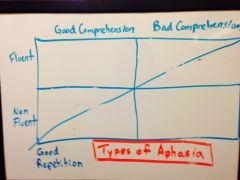
|

|
|
|
Define a watershed area.
|
the boundary between two blood supplies that is the first to hypoperfuse in low BP
|
|
|
In a watershed problem, what kind of aphasia could you get?
|
any combination of the common ones! they are all close to the watershed line
|
|
|
What sx do you have when you have a lesion of the corrsponding Broca's area on the nondominant side.
|
flat speech
|
|
|
What disorder is this?
|
expressive dysprosody
|
|
|
Define prosody.
|
the rhythm, stress, and intonation of speech
|
|
|
What is you had a lesion on the nondominant Wernicke's?
|
receptive dysprosody- can't understand emotional tone
|
|
|
Name all 12 types of aphasia/dysphasias.
|
1. Broca's 2. Wernicke's 3. TC sensory 4. TC Motor 5. TC mixed 6. Nominal 7. Global 6. Anterior BG 7. Posterior BG 8. Thalamic 9. Watershed 10. Conducting
|
|
|
did you remember 4 to the floor for primary motor?
|
then you need to write **** down!
|

